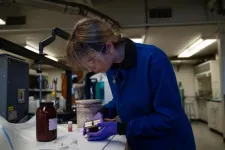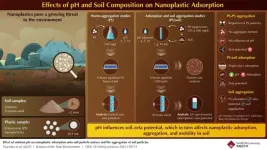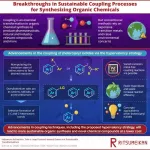(Press-News.org) University of Oregon chemists are bringing a greener way to make iron metal for steel production closer to reality, a step towards cleaning up an industry that’s one of the biggest contributors to carbon emissions worldwide.
Last year UO chemist Paul Kempler and his team reported a way to create iron with electrochemistry, using a series of chemical reactions that turn saltwater and iron oxide into pure iron metal.
In their latest work, they’ve optimized the starting materials for the process, identifying which kinds of iron oxides will make the chemical reactions the most cost-effective. That’s a key to making the process work at an industrial scale.
“We actually have a chemical principle, a sort of guiding design rule, that will teach us how to identify low-cost iron oxides that we could use in these reactors,” Kempler said.
The research was published April 9 in ACS Energy Letters.
Almost 2 billion metric tons of steel were produced worldwide in 2024, used in everything from buildings to cars to infrastructure. Currently, the most fossil fuel-intensive part of that process is turning iron ore — the oxidized form of iron that’s found in nature — into pure iron metal.
Traditionally done in blast furnaces that send carbon dioxide into the atmosphere, Kempler’s team is developing a different approach to iron production.
Their process starts with saltwater and iron oxide, which are cheap and available, and transforms them into iron metal through a series of chemical reactions. Those reactions conveniently also produce chlorine, a commercially valuable byproduct.
When Kempler and his team began developing their process a few years ago, they started with small quantities of iron oxides from chemical supply companies.
Those materials worked well in lab tests. But they didn’t reflect the kind of iron-rich materials found naturally, which have much more variation in composition and structure.
“So then a very natural next question was: What happens if you actually try to work with something which was dug out from the earth directly, without being extra purified, extra milled, and so on?” said Ana Konovalova, who co-led the project as a postdoctoral researcher in Kempler’s lab.
As the team experimented with different kinds of iron oxides, it was clear that some worked much better than others. But the researchers weren’t sure what was driving the difference in the amount of iron metal they could generate from different starting materials. Was it the size of the iron oxide particles? The composition of the material? The presence or absence of specific impurities?
Konovalova and graduate student Andrew Goldman found creative ways to test certain variables while keeping others the same.
For example, they took iron oxide powder and made it into nanoparticles. They put some of the nanoparticles through a heat treatment that made them much denser and less porous.
“It solidifies into this same secondary nanoparticle shape, but there are no more primary particles observed inside. It’s essentially the same material, just in different stages,” Konovalova said.
In lab tests, the difference was striking: “With the really porous particles, we can make iron really quickly on a small area,” Goldman said. “The dense particles just can't achieve the same rate, so we’re limited in how much iron we can make per square meter of electrodes.”
That’s a key insight for making the process work at an industrial scale, where success often comes down to economics.
Large-scale electrochemical plants are expensive to build, and that cost scales with electrode area. To make it economically viable, the electrodes need to be able to generate enough product quickly enough to pay off the initial investment. The faster rate of reaction of the porous particles means the initial capital cost can be recouped faster, translating into a lower final cost for the iron product, ideally low enough to be competitive with conventional methods.
The takeaway isn’t that these specific nanoparticles are needed to make the electrochemical process work well, Kempler said. Rather, the study suggests that the surface area of the starting materials really matters. The porous nanoparticles had much more surface area for the reaction to take place, making the reaction run faster. Other iron oxides with a porous structure could also be cost-effective.
“The goal is to find something that's abundant, cheap and that’s going to have a smaller environmental impact than the alternative,” Kempler said. “We won't be satisfied if we invent something that’s more damaging than the main way that we make iron today.”
To take their process beyond the lab, Kempler’s lab is working with researchers in other fields. A collaboration with civil engineers at Oregon State University is helping them better understand what’s needed for the product to work in real-world applications. And collaboration with an electrode manufacturing company is helping them address the logistical and scientific challenges of scaling up an electrochemical process.
“I think what this work shows is that technology can meet the needs of an industrial society without being environmentally devastating,” Goldman said. “We haven't solved all the problems yet, of course, but I think it's an example that serves as a nucleation point for a different way of thinking about what solutions look like. We can continue to have industry and technology and medicine, and we can do it in a way that’s clean — and that’s awesome!”
— By Laurel Hamers, University Communications
This research was supported by the U.S. Department of Energy.
END
University of Oregon scientists advance a greener way to produce iron
If scaled up, the process could help cut carbon emissions in the steel industry
2025-04-09
ELSE PRESS RELEASES FROM THIS DATE:
Nanoplastics in soil: how soil type and pH influence mobility
2025-04-09
Plastics are everywhere—from packaging and textiles to electronics and medical devices. As plastic waste breaks down, it releases microscopic particles that can penetrate our ecosystems, hinder plant growth, and potentially transfer harmful pollutants to organisms, including humans. Therefore, these plastic particles are a potential threat to the ecosystem, especially in their nanoparticulate form (1–100 nm diameter), which can penetrate the environment through different routes, including the soil beneath our feet.
With this in mind, a team of researchers from Japan set out to study the migration behavior of nanoplastics ...
Rethinking coupling methods for more sustainable organic synthesis
2025-04-09
Coupling reactions are among the most transformative tools in organic chemistry, enabling the formation of crucial chemical bonds in pharmaceuticals, agrochemicals, and advanced materials. Since their introduction, they have been one of the backbones of modern organic synthesis. However, these methods have long relied on environmentally taxing transition metal catalysts, such as palladium, which are often scarce, costly, and generate unwanted byproducts.
The limitations of conventional coupling methods have prompted researchers to seek alternative strategies that better align with the principles of green and sustainable chemistry ...
UN University: five deep changes urgently needed for a sustainable world and how to achieve them
2025-04-09
Amid deepening inequalities and escalating crises, including climate change, biodiversity loss and pollution, a new United Nations report presents a bold approach for change.
The 2025 Interconnected Disaster Risks report, Turning Over a New Leaf, issued by the UN University’s Institute for Environment and Human Security (UNU-EHS), shifts focus from diagnosing problems to mapping out solutions. It establishes that many of today’s solutions are surface-level fixes, and that to create ...
Ohio State study reveals new insights into neurodegeneration using human ‘mini brains’
2025-04-09
COLUMBUS, Ohio – Researchers at The Ohio State University Wexner Medical Center and College of Medicine have discovered a new way that neurons act in neurodegeneration by using human neural organoids – also known as “mini-brain” models – from patients with frontotemporal lobar degeneration (FTLD).
Understanding this new pathway could help researchers find better treatments for FTLD and Alzheimer’s, the two most common forms of dementia that lead to cognitive decline.
Researchers used advanced techniques to study neurons from ...
Decarbonization improves energy security for most countries, Stanford study finds
2025-04-09
A pivot from fossil fuels to clean energy technologies by 2060 would improve energy security and reduce trade risks for most nations, according to an April 9 study in Nature Climate Change.
Lithium, nickel, cobalt, copper, and rare earth minerals are among the prized materials for countries and corporations racing to secure supplies for energy systems that do not add greenhouse gases to our atmosphere. Unlike fossil fuels, natural reserves of these materials are most concentrated in the Global South, shuffling the geopolitics of energy and global trade.
“Most people ...
Poor oral health linked with body pain and migraines in women
2025-04-09
New research from the University of Sydney has revealed poor oral health is significantly associated with higher instances of migraines, abdominal and body pain in women.
Published in Frontiers in Pain Research, the world-first study identified specific oral microbes correlated with certain pain conditions, suggesting a potential relationship between the oral microbiome and the nervous system.
The findings highlight the importance of good oral health to potentially mitigate pain and improve overall wellbeing, prompting further exploration into the role of oral microbiota in chronic unexplained ...
How is climate change affecting seasonal allergies?
2025-04-09
A review published in The Laryngoscope indicates that climate change’s effects on pollen seasons and concentrations are contributing to increasing rates of allergic rhinitis, or hay fever.
When investigators assessed research published between 2000 and 2023, they identified 30 studies that reported on the current epidemiological state of allergic rhinitis, described factors related to climate change, and observed how global warming is affecting pollen seasons and allergy symptoms.
Sixteen studies reported longer pollen seasons and/or higher pollen concentrations related to climate change. As an example, total pollen emissions in the U.S. are projected to increase by 16–40% ...
Does universal preschool lead to better academic outcomes?
2025-04-09
Several states, including Georgia, offer state-funded pre-kindergarten programs to students regardless of their family’s income. New research in Economic Inquiry investigates whether such programs offer long-lasting academic benefits to all students.
Using enrollment lottery data from a large school district in metro Atlanta, investigators found that lottery-winning enrollees of school-based pre-kindergarten entered kindergarten more prepared in both math and reading than non-winning peers. Gains tended to fade by the end of kindergarten, however, and some negative achievement effects ...
Could fish swim bladders be useful in a treatment for heart failure?
2025-04-09
Hydrogels, which are soft materials formed by crosslinking polymers, could have a variety of medical applications. In research published in Advanced Science, investigators developed an injectable hydrogel containing components of fish swim bladders and used it to repair damaged heart tissue.
The fish swim bladder is an organ that aids fish in floating in water and is composed of collagen, glycosaminoglycans, and elastin, closely resembling parts of the human heart.
Experiments revealed that the researchers’ fish swim bladder–based hydrogel enhances cardiac cell adhesion and stretching while promoting new ...
Does cancer treatment affect connections in the brain?
2025-04-09
New research published in the Journal of Magnetic Resonance Imaging has uncovered changes in brain connectivity during chemotherapy in patients with breast cancer.
In the study of 55 patients with breast cancer and 38 controls without cancer, investigators conducted functional magnetic resonance imaging scans of participants’ brains over several months.
Scans from patients revealed changes in brain connectivity, particularly in the frontal-limbic system (involved in executive functions) and the cerebellar cortex (linked to memory) throughout the course of treatment. These changes got worse and spread more as chemotherapy continued.
“The ...
LAST 30 PRESS RELEASES:
Norbert Holtkamp appointed director of Fermi National Accelerator Laboratory
New agentic AI platform accelerates advanced optics design
Biologists discover neurons use physical signals — not electricity — to stabilize communication
Researchers discover that a hormone can access the brain by hitchhiking
University of Oklahoma researcher awarded funding to pursue AI-powered material design
Exploring how the visual system recovers following injury
Support for parents with infants at pediatric check-ups leads to better reading and math skills in elementary school
Kids’ behavioral health is a growing share of family health costs
Day & night: Cancer disrupts the brain’s natural rhythm
COVID-19 vaccination significantly reduces risk to pregnant women and baby
The role of vaccination in maternal and perinatal outcomes associated with COVID-19 in pregnancy
Mayo Clinic smartwatch system helps parents shorten and defuse children's severe tantrums early
Behavioral health spending spikes to 40% of all children’s health expenditures, nearly doubling in a decade
Digital cognitive behavioral treatment for generalized anxiety disorder
Expenditures for pediatric behavioral health care over time and estimated family financial burden
Air conditioning in nursing homes and mortality during extreme heat
The Alps to lose a record number of glaciers in the next decade
What makes a good proton conductor?
New science reporting guide published for journalists in Bulgaria
New international study reveals major survival gaps among children with cancer
New science reporting guide published for journalists in Turkey
Scientists develop a smarter mRNA therapy that knows which cells to target
Neuroanatomy-informed brain–machine hybrid intelligence for robust acoustic target detection
Eight SwRI hydrogen projects funded by ENERGYWERX
The Lundquist Institute and its start-up company Vitalex Biosciences Announces Strategic Advancement of Second-Generation fungal Vaccine VXV-01 through Phase 1 Trials under $40 Million Competitive Con
Fine particles in pollution are associated with early signs of autoimmune disease
Review article | Towards a Global Ground-Based Earth Observatory (GGBEO): Leveraging existing systems and networks
Penn and UMich create world’s smallest programmable, autonomous robots
Cleveland researchers launch first major study to address ‘hidden performance killer’ in athletes
To connect across politics, try saying what you oppose
[Press-News.org] University of Oregon scientists advance a greener way to produce ironIf scaled up, the process could help cut carbon emissions in the steel industry




